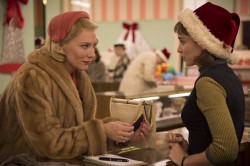Cinema | January 18th, 2016

by Greg Carlson
The meticulous Todd Haynes shares another engrossing 1950s tale of forbidden romance with “Carol,” a thematic sibling to the director’s career high point “Far from Heaven.” Adapted by Phyllis Nagy from Patricia Highsmith’s bracing novel “The Price of Salt,” “Carol” is every bit as feverish as the legendary anecdote describing the book’s origin. In the title role, Cate Blanchett is a well-to-do woman who might possibly be pursuing the distractions of Therese, Rooney Mara’s young salesgirl, just as much as the custody of her daughter during a difficult divorce. Filled with the loaded communication of the glance and the gaze, “Carol” is a lush and aching love story.
The movie may be called “Carol,” but the point of view belongs equally to Therese. Blanchett and Mara are good enough to expect more award nominations headed their way, and Haynes deftly balances the performances, constructing with the actors a careful pas de deux that accesses the hearts of both characters. Whether or not Carol uses her power, experience, and social status to seduce Therese, the drama clearly carves out room to examine how women in post-World War II America found themselves, regardless of sexual orientation, confined to customs determined by repressive norms.
Admirers of Haynes will find an embarrassment of riches in the lines of Carol’s stunning gray 1949 Packard Super Deluxe 8, the exterior of the Spare-Time diner, and the sight and sound of the Teddy Wilson/Billie Holiday microgroove long player featuring “Easy Living.” Anthony Lane writes of the necessity of retaining the novel’s period setting: “If Haynes had updated ‘The Price of Salt’ to the present, our response would have been: big deal. Trade your straight marriage for a same-sex relationship, these days, and you will be hailed for your emotional honesty, whereas Highsmith, steeped in crime fiction, needed the creak of danger and the hiss of social disdain.” Lane’s assertion is worth considering, even though “Carol,” with its sumptuous costumes and production design, centralizes and fetishizes the cool of the mid-twentieth century.
Over time, the novel’s open-ended and hopeful conclusion has remained one of its most frequently cited talking points. Because Highsmith resisted prevailing attitudes and expectations about the ways in which homosexual characters could or should be portrayed in fiction, interest in the book has continued (even though it was for a time out of print). Just as astonishing is the novel’s influence on Nabokov. As Terry Castle has long maintained, the tingly road trip centerpiece – a throbbing fantasy of anticipation – “must have [been] stolen” for “Lolita.”
“Carol” has already emerged, deservedly so, as a critical darling, but the film is not without its minor shortcomings. In significant ways, Highsmith depicted nervous confusion and sexual heat with an edge that Haynes blunts in favor of a more tasteful and highbrow rendering of Carol and Therese’s affair. Additionally, the age and class difference between the two women merits only scant notice within the film narrative, despite providing a potentially rich vein for deeper exploration. Minor quibbles aside, however, “Carol” is an absolutely ravishing feast for the senses. Lovers of classic Hollywood glamour will swear Mr. Haynes and his crew found a functional time machine.
December 29th 2025
December 29th 2025
December 16th 2025
December 9th 2025
December 2nd 2025
__293px-wide.jpg)
_(1)__293px-wide.jpg)
_(1)__293px-wide.jpg)
_(1)__293px-wide.png)
_(1)_(1)_(1)__293px-wide.jpg)
